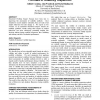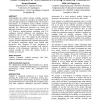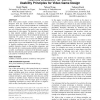AVI
2000
13 years 6 months ago
2000
The Cognitive Dimensions framework outlined here is generalised broad-brush approach to usability evaluation for all types of information artifact, from programming languages thro...
CHI
2002
ACM
14 years 4 months ago
2002
ACM
Evaluators who examine the same system using the same usability evaluation method tend to report substantially different sets of problems. This so-called evaluator effect means th...
CHI
2004
ACM
14 years 4 months ago
2004
ACM
Structured Problem Report Formats have been key to improving the assessment of usability methods. Once extended to record analysts' rationales, they not only reveal analyst b...
CHI
2007
ACM
14 years 5 months ago
2007
ACM
Understanding the relation between usability measures seems crucial to deepen our conception of usability and to select the right measures for usability studies. We present a meta...
CHI
2008
ACM
14 years 5 months ago
2008
ACM
Most video games require constant interaction, so game designers must pay careful attention to usability issues. However, there are few formal methods for evaluating the usability...
CHI
2009
ACM
14 years 5 months ago
2009
ACM
Post-task ratings of difficulty in a usability test have the potential to provide diagnostic information and be an additional measure of user satisfaction. But the ratings need to...



